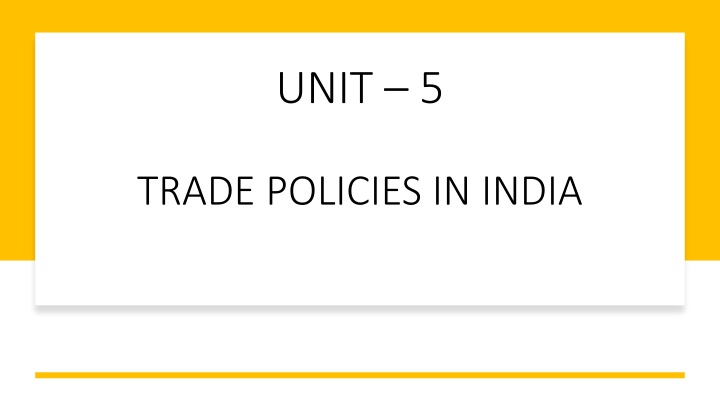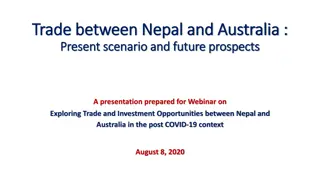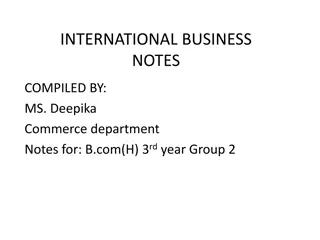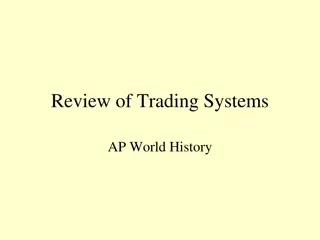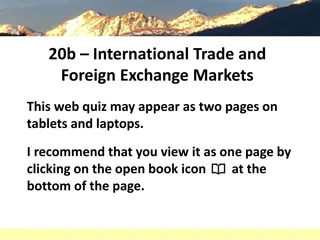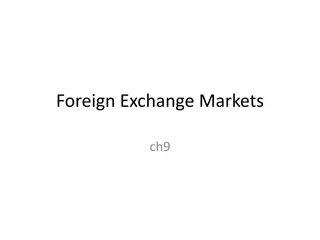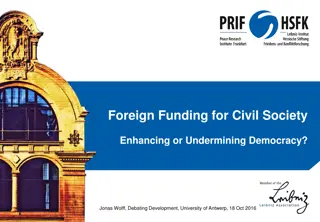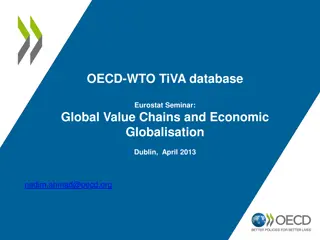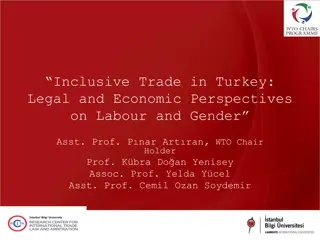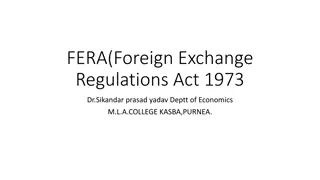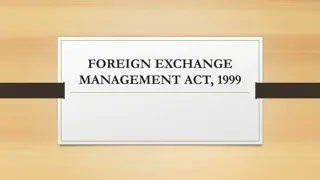India's Foreign Trade Policies Overview
India's Foreign Trade Policy (FTP) aims to boost exports by adapting to changing domestic and global scenarios. Recent changes include strategies to double exports by 2025 and improve market share in existing and new markets. The policy also focuses on enhancing the ease of trading, promoting exports from various sectors, and involving state governments in export strategies. Trade reforms since the 1990s have aimed to improve India's trade and payments situation.
Download Presentation

Please find below an Image/Link to download the presentation.
The content on the website is provided AS IS for your information and personal use only. It may not be sold, licensed, or shared on other websites without obtaining consent from the author.If you encounter any issues during the download, it is possible that the publisher has removed the file from their server.
You are allowed to download the files provided on this website for personal or commercial use, subject to the condition that they are used lawfully. All files are the property of their respective owners.
The content on the website is provided AS IS for your information and personal use only. It may not be sold, licensed, or shared on other websites without obtaining consent from the author.
E N D
Presentation Transcript
UNIT 5 TRADE POLICIES IN INDIA
INDIAS FOREIGN TRADE POLICY The Department of Commerce has the mandate to make India a major player in global trade and assume a role of leadership in international trade organizations commensurate with India's growing importance. The Department devises commodity and country-specific strategy in the medium term and strategic plan/vision and India's Foreign Trade Policy in the long run. 5.1 RECENT CHANGES IN THE DIRECTION AND COMPOSITION OF TRADE
INDIAS FOREIGN TRADE POLICY India's Foreign Trade Policy (FTP) provides the basic framework of policy and strategy for promoting exports and trade. It is periodically reviewed to adapt to the changing domestic and international scenario. he Department is also responsible for multilateral and bilateral commercial relations, special economic zones (SEZs), state trading, export promotion and trade facilitation, and development and regulation of certain export oriented industries and commodities. 5.1 RECENT CHANGES IN THE DIRECTION AND COMPOSITION OF TRADE
INDIAS FOREIGN TRADE POLICY The current Foreign Trade Policy (2015-20) focusses on improving India's market share in existing markets and products as well as exploring new products and new markets. India's Foreign Trade Policy also envisages helping exporters leverage benefits of GST, closely monitoring export performances, improving ease of trading across borders, increasing realization from India's agriculture- based exports and promoting exports from MSMEs and labour intensive sectors. The DOC has also sought to make states active partners in exports. As a consequence, state governments are now actively developing export strategies based on the strengths of their respective sectors. 5.1 RECENT CHANGES IN THE DIRECTION AND COMPOSITION OF TRADE
INDIAS FOREIGN TRADE POLICY 5.1 RECENT CHANGES IN In 2018, then Commerce & Industry Minister Shri Suresh Prabhu envisaged a strategy to double India's exports by 2025. The approach included devising a commodity specific strategy for key sectors like gems and jewellery, leather, textile & apparel, engineering sector, electronics, chemicals and petrochemicals, pharma, agri and allied products and marine products. Territory specific strategy will cover North American Free Trade Agreement (NAFTA), Europe, North East Asia, ASEAN, South Asia, Latin America, Africa and WANA, Australia, New Zealand, and CIS. THE DIRECTION AND COMPOSITION OF TRADE
INDIAS FOREIGN TRADE POLICY 5.1 RECENT CHANGES IN The trade reforms initiated in the country since the beginning of 1990's were directed to achieve the basic objective of bringing about definite and permanent improvement in trade and payments situation in the country THE DIRECTION AND COMPOSITION OF TRADE
Impact of trade Reforms The impact of the liberalisation of trade policies upon the economy of the country is as follows: Shift Front Inward-Looking Trade Policies to Outward-Look Trade Policies: 2. Balance of Payments: 3. Inflow of Foreign Capital: 4. Industrial Growth: 5. Extent of Employment: 5.2 IMAPCT OF TRADE REFORMS
Impact of trade Reforms 6. Economic Growth: The GDP growth rates were estimated at 6.6 percent and 7.4 percent for 201314 and 2014-15 respectively. External debt of External debt of India 5.2 IMAPCT OF TRADE REFORMS
Problem of Indias International Debt The external debt of India is the total debt the country owes to foreign creditors. The debtors can be the Union government, state governments, corporations or citizens of India. The debt includes money owed to private commercial banks, foreign governments, or international financial institutions such as the International Monetary Fund (IMF) and World Bank. India's external debt data is published quarterly, with a lag of one quarter. Statistics for the first two quarters of the calendar year are compiled and published by the Reserve Bank of India. Data for the last two quarters is compiled and published by the Ministry of Finance. 5.3 PROBLEM OF INDIA S INTERNATIONAL DEBT
Problem of Indias International Debt 5.3 PROBLEM OF INDIA S INTERNATIONAL The Government of India also publishes an annual status report on the debt which contains detailed statistical analysis of the country s external debt position. As on 31 December 2019, India's external debt stock totalled US$563.9 billion, a quarter-over quarter increase of 1 .2%. DEBT
Introduction to Multinational Corporations: An important development in the post-war period is that of the spread of multinational corporations (MNCs) as the vehicle of foreign direct investments. These are also called as Transnational Corporations (TNCs). Salvatore has defined them in these words, "These are the firms that own, control or manage production facilities in several countries." Paul Streeten and S. Lal have defined MNCs from economic, organisational and motivational viewpoints. 5.4 WORKING AND REGULATION OF MNC
Introduction to Multinational Corporations: 5.4 WORKING The economic definition of MNCs lays stress on the size, geographical spread and magnitude of investment. As regards the size or scale of operation, a typical MNC has net sales of 100 million dollars or more. From the geographical viewpoint a MNC is not confined to the national frontiers of the country of its origin. It spreads over two or more countries and therefore has an international character. As regards the magnitude of foreign investment, it varies from 25 percent to 100 percent. AND REGULATION OF MNC
Introduction to Multinational Corporations: From organisational point of view, MNC is one that acts as an organisation, maximising one overall objective for all its units and one which has the whole world (or parts of it) as its area of operation. In other words, MNC has its subsidiaries or branches spread over in different countries with single headquarter in the country of origin to co-ordinate the activities of all its branches. chief characteristics of multinational corporations (MNCs) or transnational corporations (TNCs) are as follows: 5.4 WORKING AND REGULATION OF MNC
Introduction to Multinational Corporations: They operate on a large scale having assets or sales in billions of dollars. They operate internationally through a central office in the country of origin. They have an oligopolistic structure and deal in differentiated products. They try to bring about a collective transfer of resources like machinery, equipment, technological know-how, materials, finance and managerial services. 5.4 WORKING AND REGULATION OF MNC
Introduction to Multinational Corporations: Spread of MNCs: 5.4 WORKING During the last few decades, MNCs have assumed a dominant position international production, trade, investment and technological transfer. A study made by R. Vernon in 1971 listed 100 large MNCs, the total production of which stood 350 billion a year. A large majority them was controlled by the U.S.A. followed by the United Kingdom. total number of MNCs in the early 1970's was about 7000. Some of had assumed really gigantic scal operation. AND REGULATION OF MNC
Role of MNCs. The MNCs have become a very powerful force in the world economy during the last few decades. They have exercised a revolutionary effect on international economic system in general and industrial organisation in particular. It has been truly regarded as a remarkable economic phenomenon of the twentieth century. We assess here the role of MNCs from the point of view of the LDCs. The benefits of these organisations are based upon the theory of foreign direct investments. 5.4 WORKING AND REGULATION OF MNC
These are given below: Transfer of Capital: Undertaking Risk: Transfer Superior Technology: Development Markets: Development of Human Resources: Fuller Utilisation of Natural Resources: Infrastructure: Industrial Linkages: 5.4 WORKING AND REGULATION OF MNC
Adverse Effects of MNCs: The MNCs are viewed with much distrust in the LDCs because their operations involve exploitation of men, materials and markets of these countries. They have failed to raise up to their expectations and have many adverse consequences for them. No Commitment to Economic and Social Development: Disincentive for Domestic Capital: Low Government Revenues: Low Foreign Exchange Earnings: Unsuited Technology: Heavy Cost of Transfer of Technology: 5.4 WORKING AND REGULATION OF MNC
Export Promotion Measures in India 5.5 A number of institutions have been set up by the government of India to promote exports. The export and import functions are looked after by the Ministry of Commerce. The Government formulates the export import policies and programmes that give direction to the exports. Exim policies aim at export assistance such as export credit, cash assistance, import replenishment, licensing, free trade zones, development of ports, quality control and pre-shipment IMPROVEMENT OF EXPORT PROMOTION
Export Promotion Measures in India 5.5 Exim policies aim at export assistance such as export credit, cash assistance, import replenishment, licensing, free trade zones, development of ports, quality control and pre-shipment inspection, and guidance to Indian entrepreneurs to set up ventures abroad. 1. International Presence 2. Export Promotion Council 3. Setting up of Commodity boards to promote exports IMPROVEMENT OF EXPORT PROMOTION
Export Promotion Measures in India 4. Trade reps 5.5 5. Indian Institute of Foreign Trade IMPROVEMENT OF EXPORT PROMOTION 6. Participation 7. Trade development Authority 8. Financing for export 9. Advisory Councils 10. Technical assistance and Training
